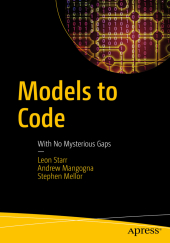 Neuerscheinungen 2017Stand: 2020-02-01 |
Schnellsuche
ISBN/Stichwort/Autor
|
Herderstraße 10
10625 Berlin
Tel.: 030 315 714 16
Fax 030 315 714 14
info@buchspektrum.de |

Andrew Mangogna, Stephen J. Mellor, Leon Starr
(Beteiligte)
Models to Code
With No Mysterious Gaps
1st ed. 2017. xxii, 305 S. 33 SW-Abb., 70 Farbabb. 254 mm
Verlag/Jahr: SPRINGER, BERLIN; APRESS 2017
ISBN: 1-484-22216-4 (1484222164)
Neue ISBN: 978-1-484-22216-4 (9781484222164)
Preis und Lieferzeit: Bitte klicken
Learn how to translate an executable model of your application into running code. This is not a book about theory, good intentions or possible future developments. YouŽll benefit from translation technology and solid software engineering principles that are demonstrated with concrete examples using an open source tool chain.
Models donŽt deliver enough value if they are not on a direct path to code production. But to waste time building models that are merely pictures of your code doesnŽt add much value either. In this book, youŽll translate detailed, yet platform-independent models that solve real application problems.
Using a pragmatic approach, Models to Code quickly dives into two case studies of Executable UML models. The models and code are extensively annotated and illustrate key principles that are emphasized throughout the book.
YouŽll work with code production using "C" as the implementation language and targeting microcomputer class processors. This might not be your particular target language or platform, but you can use you can use what you learn here to engineer or re-evaluate your own code translation system to dramatically increase the value of both your modeling and code generation solution.
Written by three leading experts, Models to Code is an exceptional resource for producing software by model translation- add it to your library today.
What YouŽll Learn
See how detailed models resolve ambiguity and contradiction common in requirements.
Examine how a model can be detailed enough to be executable and testable while remaining platform independent
Produce code from a model, leaving the model intact so it can be redeployed on new platforms or adapted to changing software and hardware technology.
Implement platform independent model execution rules in platform specific run-time code
Who This Book Is For
Modelers and systems engineers on active MBSE projects (using Executable UML or not), projects using Simulink, Matlab, Dymola, MatrixX and other math modelling tools.
Any developers with current or past model experience, professors, students, systems engineers, embedded systems developers, or anyone interested in learning more about software modelling.
1. The Modeling Landscape
2. A Simple Executable Model
3. Making Translation Decisions
4. Translating the Air Traffic Control Model
5. Model Execution Domain
6. An Extended Example
7. Sensor and Actuator Service Domain
8. Integrating the Application and Service Domains
9. Event Polymorphism
10. Pycca and Other Platforms
11. The Translation Landscape
Appendix A. Summary of xUML
Appendix B. Scrall Overview
Appendix C. Pycca Language Overview
Appendix D. Bibliography


